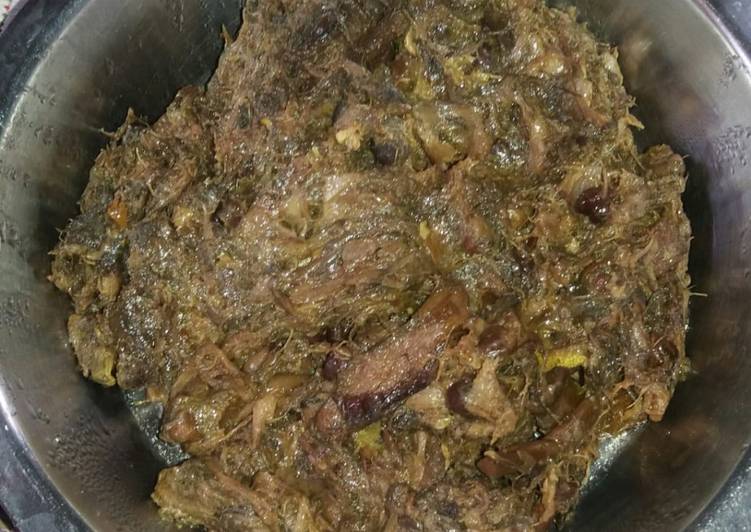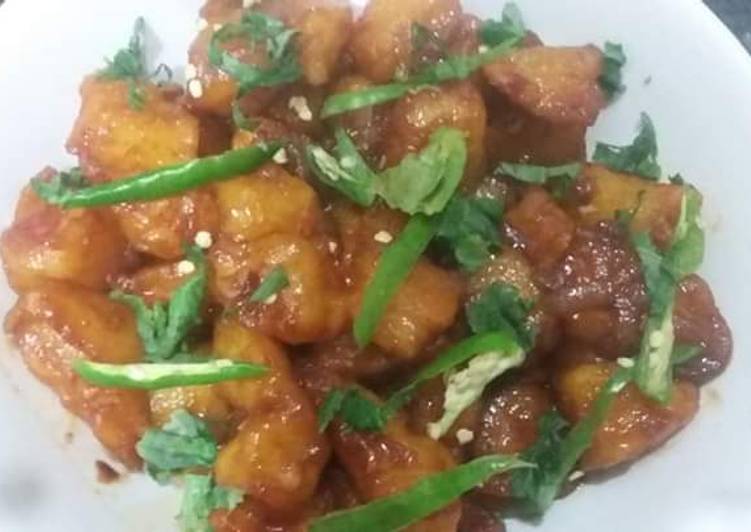
Hello everybody, hope you are having an amazing day today. Today, we’re going to prepare a special dish, kochu saak (taro stem fry). One of my favorites. This time, I will make it a bit tasty. This will be really delicious.
Kochu saak (taro stem fry) is one of the most popular of recent trending meals on earth. It is simple, it’s fast, it tastes delicious. It’s enjoyed by millions daily. They’re fine and they look wonderful. Kochu saak (taro stem fry) is something which I’ve loved my whole life.
Giant Taro leaf, we locally called it as Bumbai Kochu Shak is one type of taro tree but much bigger than normal taro tree. This taro stem or leaf or both. This is a traditional Bengali recipe of taro stem cooked with prawns.
To begin with this recipe, we have to prepare a few ingredients. You can have kochu saak (taro stem fry) using 9 ingredients and 6 steps. Here is how you can achieve that.
The ingredients needed to make Kochu saak (taro stem fry):
- Prepare 500 gm taro stem cut and steamed
- Prepare 1/2 cup boiled Bengal gram
- Make ready 1/2 cup desiccated coconut
- Prepare 1 tsp nigella seeds
- Prepare 4-5 green chillies chopped
- Prepare 1 tsp red chilli Powder
- Make ready 1/2 tsp turmeric powder
- Take To taste salt and sugar
- Prepare As needed mustard oil
Similar taro varieties include giant taro (Alocasia macrorrhizos), swamp taro (Cyrtosperma merkusii), and arrowleaf elephant's ear (Xanthosoma sagittifolium). In the east Indian state of West Bengal, taro corms are thinly sliced and fried to make chips called kochu bhaja. The stem is used to cook kochur. Taro roots are thinly sliced and fried to make chips called kochu bhaja in the East Indian state of West Bengal.
Instructions to make Kochu saak (taro stem fry):
- Heat oil and temper nigella seeds and green chillies chopped
- Now add the steamed taro stem.
- Add salt and turmeric powder and cover it till it become soft and moist
- Now add red chilli Powder,Bengal gram and mix well
- Add coconut and mix well adding sugar
- Serve it with rice
Other Traditional uses and benefits of Taro. Leaf juice is styptic, stimulant and rubefacient and is useful in internal haemorrhages, otalgia, adenitis and buboes; the juice of the corm is laxative. TARO stem recipe Taro stem with fermented fish how to cook taro stem. Village Food Recipe Kala Kochur Data Bhaji Black Taro Stem fry Cooking By Street Village Food. Village Food Kochu Bahar Recipe FARM FRESH Taro Stem With Hilsha Fish Curry Yummy Cooking Kochu Data.
So that is going to wrap it up for this special food kochu saak (taro stem fry) recipe. Thanks so much for your time. I am confident you will make this at home. There is gonna be interesting food in home recipes coming up. Don’t forget to bookmark this page on your browser, and share it to your loved ones, friends and colleague. Thank you for reading. Go on get cooking!

